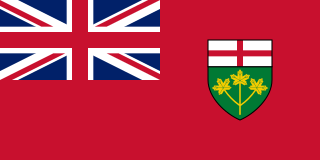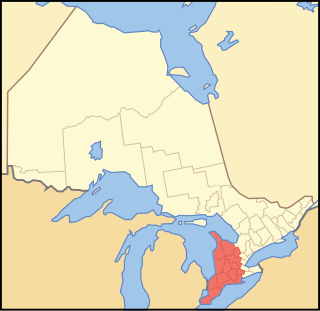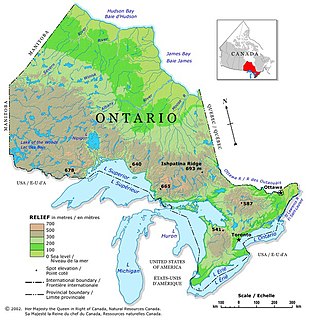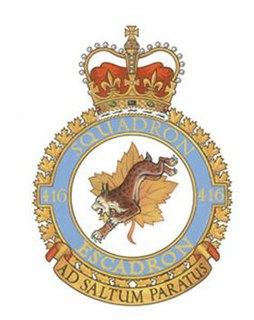
Lake Ontario is one of the five Great Lakes of North America. It is surrounded on the north, west, and southwest by the Canadian province of Ontario, and on the south and east by the U.S. state of New York, whose water boundaries meet in the middle of the lake.

Ontario is one of the thirteen provinces and territories of Canada. Located in Central Canada, it is Canada's most populous province, with 38.3 percent of the country's population, and is the second-largest province by total area. Ontario is Canada's fourth-largest jurisdiction in total area when the territories of the Northwest Territories and Nunavut are included. It is home to the nation's capital city, Ottawa, and the nation's most populous city, Toronto, which is also Ontario's provincial capital.

Central Canada is a region consisting of Canada's two largest and most populous provinces: Ontario and Quebec. Geographically, they are not at the centre of Canada but instead overlap with Eastern Canada toward the east. Because of their large populations, Ontario and Quebec have traditionally held a significant amount of political power in Canada, leading to some amount of resentment from other regions of the country. Before Confederation, the term "Canada" specifically referred to Central Canada. Today, the term "Central Canada" is less often used than the names of the individual provinces.

Southern Ontario is a primary region of the province of Ontario, Canada, the other primary region being Northern Ontario. It is the most densely populated and southernmost region in Canada. The exact northern boundary of Southern Ontario is disputed; however, the core region is situated south of Algonquin Park, the latter being in an area of transition between coniferous forest north of the French and Mattawa Rivers and southern deciduous forest. It covers between 14 and 15% of the province, depending on the inclusion of the Parry Sound and Muskoka districts which also lie in the transitional area between northern and southern forest regions. With approximately 13.5 million people, the region is home to approximately 36% of Canada's population of 37.0 million.

Northwestern Ontario is a secondary region of Northern Ontario in the Canadian province of Ontario which lies north and west of Lake Superior and west of Hudson Bay and James Bay. It includes most of subarctic Ontario. Its western boundary is the Canadian province of Manitoba, which disputed Ontario's claim to the western part of the region. Ontario's right to Northwestern Ontario was determined by the Judicial Committee of the Privy Council in 1884 and confirmed by the Canada Act, 1889, of the Parliament of the United Kingdom. In 1912, the Parliament of Canada by the Ontario Boundaries Extension Act gave jurisdiction over the District of Patricia to Ontario, thereby extending the northern boundary of the province to Hudson Bay.

The colony of Canada was a French colony within the larger territory of New France. Jacques Cartier claimed territory for France in 1535 during his second voyage of discovery, asserting possession in the name of the French king, Francis I. The colony remained a French territory until 1763, when it became a British colony known as the Province of Quebec.

Southwestern Ontario is a secondary region of Southern Ontario in the Canadian province of Ontario. It occupies most of the Ontario Peninsula bounded by Lake Huron, including Georgian Bay, to the north and northwest; the St. Clair River, Lake St. Clair, and Detroit River, to the west; and Lake Erie to the south. To the east, on land, Southwestern Ontario is bounded by Central Ontario and the Golden Horseshoe. The region had a population of 2,583,544 in 2016. It is sometimes further divided into "Midwestern Ontario" covering the eastern half of the area and the heart of Southwestern Ontario encompassing the western half of the region.

Prehistoric Park is a six-part docu-fiction television mini-series that premiered on ITV on 22 July 2006 and on Animal Planet on 29 October 2006. The programme was produced by Impossible Pictures, who also created Walking with Dinosaurs. Each episode is an hour long including commercial breaks. Repeats of the show are broadcast in the UK on Watch.

Ontario is located in East/Central Canada. It is Canada's second largest province in total land area. Its physical features vary greatly from the Mixedwood Plains in the southeast to the boreal forests and tundra in the north. Ontario borders Manitoba to the west, Hudson Bay and James Bay to the north, Quebec to the east, and the Great Lakes and the United States to the south. The province is named for Great Lake Ontario, an adaptation of the Iroquois word Onitariio, meaning "beautiful lake", or Kanadario, variously translated as "beautiful water". There are approximately 250,000 lakes and over 100,000 kilometres (62,000 mi) of rivers in the province.

The Great Lakes Basin consists of the Great Lakes and the surrounding lands of the states of Illinois, Indiana, Michigan, Minnesota, New York, Ohio, Pennsylvania, and Wisconsin in the United States, and the province of Ontario in Canada, whose direct surface runoff and watersheds form a large drainage basin that feeds into the lakes. It is generally considered to also include a small area around and beyond Wolfe Island, Ontario, at the east end of Lake Ontario, which does not directly drain into the Great Lakes, but into the Saint Lawrence River.
The Port Arthur, Duluth and Western Railway (PADW) is a defunct Canadian railway that operated in Northwestern Ontario.

Vermilion Bay is an unincorporated community on Vermilion Bay on Eagle Lake in the township of Machin, Kenora District in northwestern Ontario, Canada. It is located on Ontario Highway 17 between the cities of Kenora to the west and Dryden to the east.

416 "City of Oshawa" Tactical Fighter Squadron was a unit of the Canadian Forces and the Royal Canadian Air Force. The squadron operated the CF-18 Hornet fighter jet from CFB Cold Lake in Alberta, Canada. In 2006, 416 TFS stood down and was amalgamated with 441 Tactical Fighter Squadron to form 409 Tactical Fighter Squadron.
Elliot Lake Transit is a public transportation system, which provides daily service on an hourly basis with the exception of Sundays and statutory holidays, within the small isolated city of Elliot Lake in Northern Ontario, Canada

Surfing in Canada is practised on its east and west coasts, as well as via lake surfing on the Great Lakes, and river surfing on standing waves and tidal bores.

The Toronto waterway system comprises a series of natural and man-made watercourses in the Canadian city of Toronto. The city is dominated by a large river system spanning most of the city including the Don River, Etobicoke Creek, Highland Creek, Humber River, Mimico Creek and Rouge River.














